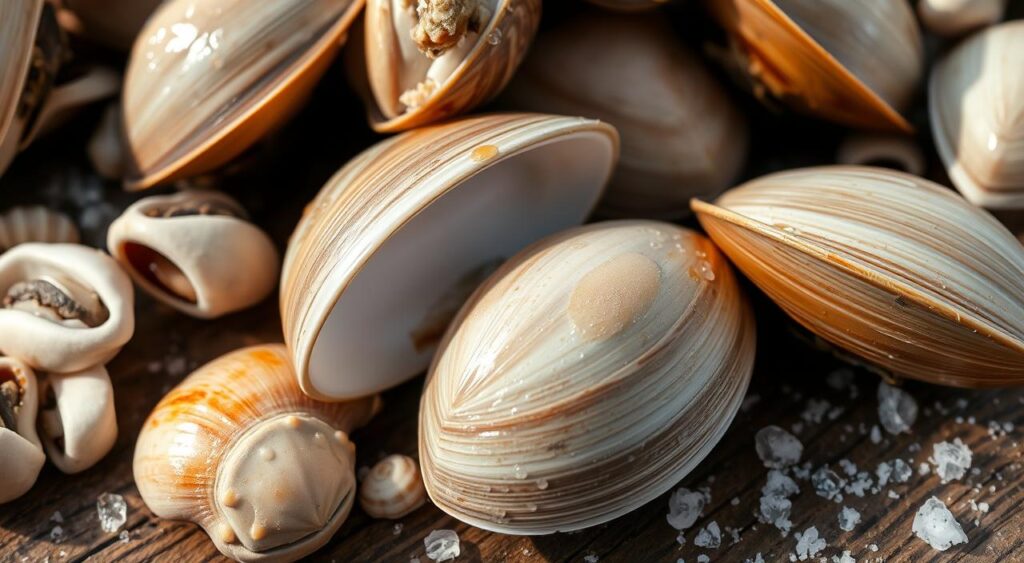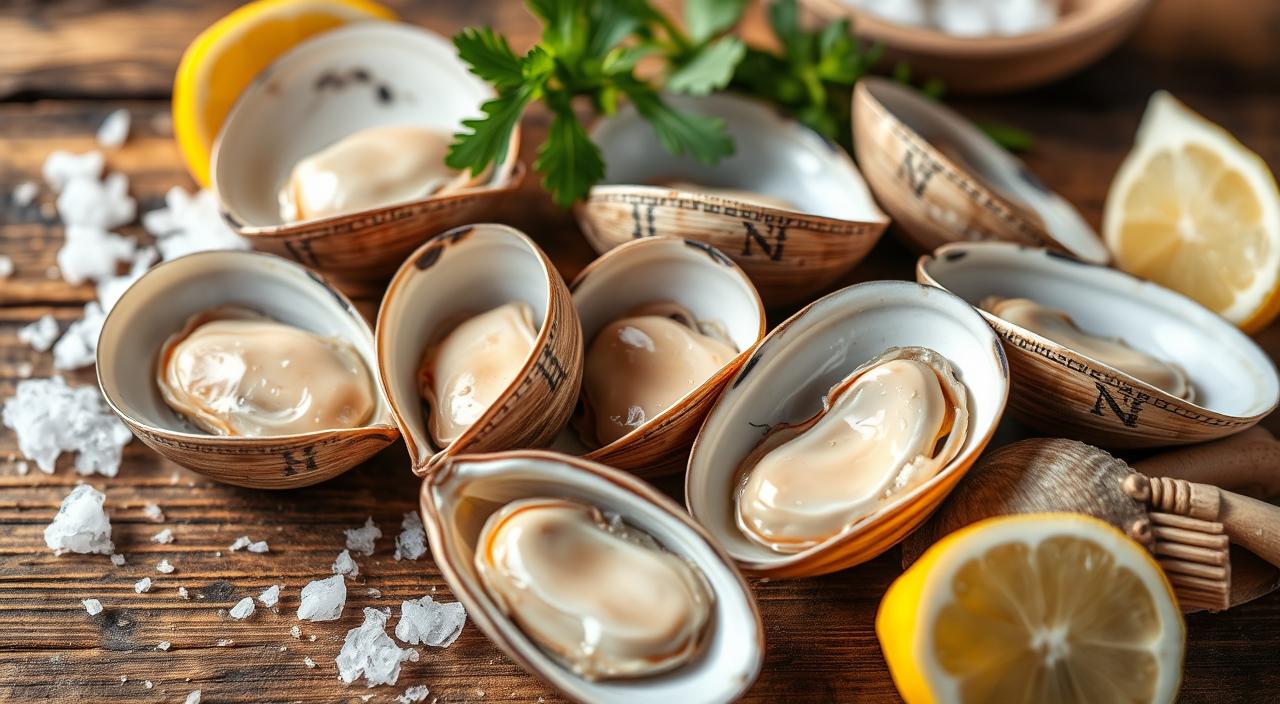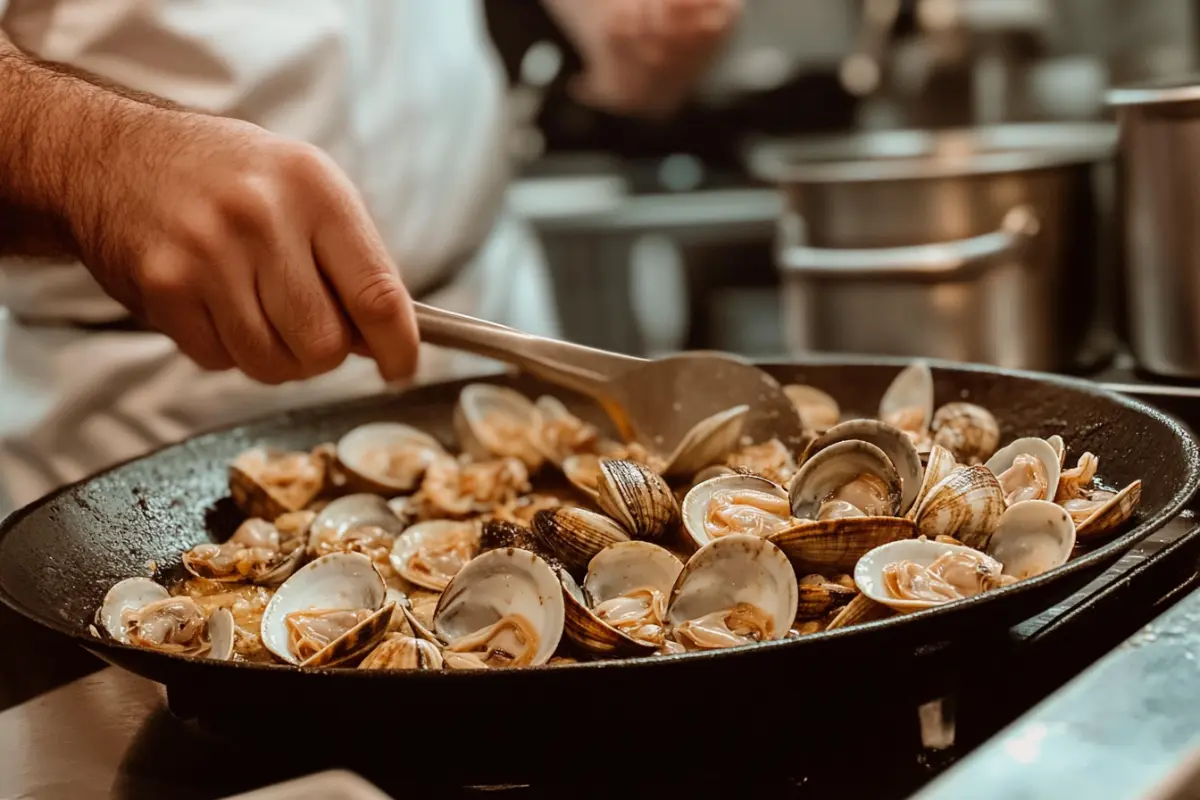I love seafood, especially fresh shellfish. They’re great in many dishes, like New England clams chowder and steamed preparations. If you’re new to cooking them, this guide will help you get started.
They are not only tasty but also nutritious, packed with protein, vitamins, and minerals. Whether you’re a seafood fan or trying something new, learning to cook these shellfish will make your meals more exciting.
Understanding Different Types of Clams
they are a diverse group of mollusks in the bivalve family. They offer a delightful culinary experience. Three popular types stand out: littleneck, cherrystone, and quahog clams. Each has unique characteristics for different dishes.
Littleneck Clams
Littleneck clams, also known as steamer clams, are the smallest and sweetest. They have about 7 to 10 clams per pound. Perfect for steaming, grilling, or raw on the half-shell, they are loved by many.
Cherrystone Clams
Cherrystone clams are larger, about 3 inches in diameter. They have a briny, robust flavor. Great for clam chowder or clam casino, they are a favorite.
Quahog Clams
Quahogs are the largest hardshell clams. They are versatile and hearty. Often used in New England clam chowder, they add substance to dishes.
Whether steaming littlenecks, shucking cherrystones, or simmering quahogs, knowing their differences is key. It helps you enjoy their full culinary potential.
Selecting and Storing Fresh Clams

When buying fresh shellfish, look for those with tightly closed shells. They should close when tapped. Avoid selecting ones that are open or won’t shut, as they may not be fresh.
Proper storage is essential to keep seafood fresh. For fresh clams, place them in a mesh colander in the fridge and cover with a damp paper towel. This keeps them cool and moist without being overly wet.
Eat them within 1-2 days for the best taste. Before cooking, check the clam selection again. Throw away any that are dead to stay safe.
When picking clams at the market, look for tight shells. Soft shell clams should move a bit in their shells or siphon.
By following these steps for selecting and storing fresh clams, you’ll enjoy their taste and texture fully. With the right care, you can enjoy the sea’s bounty in your kitchen.
Essential Tools and Ingredients for Clam Preparation
Getting ready to cook them might seem hard, but it’s easy with the right tools and ingredients. Let’s look at what you need to make tasty clam dishes.
Kitchen Equipment Needed
You’ll need a big pot or Dutch oven with a lid, a small brush for cleaning, and a colander. These tools help you work with the clams safely and well.
Basic Ingredients for Cooking
Many clam recipes start with white wine, garlic, butter, and fresh herbs. These basics give a rich flavor that lets the clams’ natural taste come through.
Optional Seasonings and Aromatics
To make it dishes even better, try adding smoked paprika, cumin, and red pepper flakes. Onions, bell peppers, and tomatoes can also add to the flavor.
For a Mediterranean flavor, use olive oil, fresh herbs, and lemon. These add a bright, lively taste to your dish.
“The key to delicious clam dishes lies in the quality of the ingredients and the care taken in their preparation.”
How to Clean and Prepare Clams
Preparing fresh clams for cooking is a simple yet crucial step. It ensures a delicious seafood dish. Whether it’s a classic clam chowder or a Mediterranean-style steamed clam feast, cleaning and purging clams is key. By following a few simple techniques, you can make sure your clams are ready to shine in your dishes.
The best way to clean them is a three-time soak in saltwater. First, mix 30 grams of salt per 1000 grams of water (about 2 tablespoons of salt per liter) in two bowls. Soak the clams in the first saltwater bath for 20 minutes, then move them to the second saltwater bowl for another 20 minutes. Finally, soak them in clean, unsalted water for 20 minutes to finish the purging.
Alternatively, you can use a quicker 30-minute soak in a single saltwater solution. This is great if you’re short on time. But the three-soak method is usually better for cleaning them and preparing shellfish of any lingering clam purging.
Whichever method you choose, scrub each clam under cool running water. Use a stiff-bristled brush to remove dirt or debris from the shells. Throw away any clams that don’t close when tapped – these are likely dead or unhealthy and should not be eaten.
Now they are clean and ready, you can start cooking. Remember, the secret to delicious, sand-free clams is a thorough cleaning process. Take the time to ensure your seafood is spotless before cooking.
Basic Cooking Methods for Clams
Preparing fresh clams can be easy and delicious. You can steam, boil, or grill them. The most important thing is to use high-quality, sustainable seafood. Follow simple steps for the best results.
Steaming Technique
Steaming is a classic method for cooking clams. Put the clams in a pot with broth. Cover and steam for 7-10 minutes until they open. Throw away any clams that don’t open.
Boiling Method
Boiling is a quick way to cook them. Put them in a large pot of salted water. Bring to a boil and cook for 5-10 minutes until they open. Don’t eat any clams that don’t open.
Grilling Approach
Grilling adds a smoky flavor to clams. You can grill them directly or in a foil packet. Cook until they open, which takes about 10 minutes. Remember, discard any clams that don’t open.
Choosing the right cooking method is important. But starting with fresh, high-quality clams is key. Clean and prepare them well before cooking. With practice, you’ll become great at cooking clams!
“The secret to perfectly cooked clams is all in the technique. Whether you’re steaming, boiling, or grilling them, the key is to not overcook and to discard any that don’t open up.”
Popular Mediterranean-Style Clam Recipes
If you enjoy tasty seafood, you’ll love Mediterranean clam recipes. These dishes are full of flavor, with Mediterranean clams, white wine, garlic, olive oil, and fresh herbs.
One favorite recipe steams Mediterranean clams in a flavorful broth. The broth includes onions, garlic, bell peppers, tomatoes, and spices like cumin and smoked paprika. After 7 to 10 minutes, they are tender and full of flavor. Enjoy with crusty bread to soak up the broth.
Another recipe adds spicy chorizo to the mix. The chorizo’s salty, smoky taste pairs well with the Mediterranean clams. This dish is quick to make, perfect for a weeknight meal.
Choosing the right Mediterranean-style clam recipe means starting with fresh Mediterranean clams. Cleaning and purging the clams is key for a great meal. With the right ingredients and techniques, you can bring Mediterranean flavors to your table. Impress your guests with these delicious seafood dishes.
Classic New England Clam Dishes
New England clams are celebrated in dishes like traditional clam chowder, clam bake, and fried clams. These dishes show off the region’s seafood heritage. They highlight the natural sweetness and briny taste of fresh clams.
Traditional Clam Chowder
New England clam chowder is a creamy soup with New England clams, potatoes, onions, and dairy broth. You’ll need 4 cups of clam juice, which can be fresh or frozen. Let the flavors mix well, so the clams‘ sweetness shines in the broth.
Clam Bake Essentials
A New England clam bake is a feast with seafood like lobster, corn, and potatoes. These are steamed together, filling the air with the clams‘ briny scent. It’s a shared dining experience that embodies coastal New England’s cuisine.
Fried Clams
Fried clams are a must-try on the New England coast. They’re made by dipping fresh clams in batter and frying until crispy. Enjoy them with tartar sauce or lemon, a true summer delight.
“The essence of New England cuisine is captured in the simple yet delightful preparations of these classic clam dishes.”
Broth Combinations for Steaming
Choosing the right liquid for steaming clams can greatly enhance the flavor. It complements the clams’ natural brininess. Adding garlic, shallots, and herbs like thyme or oregano can make it even better.
For those who don’t drink wine, clam juice or light vegetable broth are great alternatives. You can also add lemon juice, butter, or cream for a richer taste. This liquid can be used as a dipping sauce or for pasta, making sure no flavor is wasted.
It’s important to let the clams simmer for 5-10 minutes until they open. This gentle cooking keeps their texture and sweetness intact. It makes for a truly memorable meal.

FAQ
What are the different types of clams?
Clams come in three main varieties: littleneck, cherrystone, and quahog. Littleneck clams are small and sweet, perfect for steaming or eating raw. Cherrystone clams are larger with a brinier taste, while quahog clams are the largest and commonly used in chowder.
How do I select and store fresh clams?
Look for live clams with shells that are tightly closed. If the shell doesn’t close when tapped, it’s no good. Store them in the fridge for 1-2 days. Keep them cool and moist, but avoid storing in water.
What equipment and ingredients are needed to cook clams?
You’ll need a large pot or Dutch oven with a lid, a brush for cleaning, and a colander. The essential ingredients include white wine, garlic, butter, and herbs. For extra flavor, you can add smoked paprika, cumin, and red pepper flakes. Onions, bell peppers, and tomatoes also enhance the dish.
How do I clean and prepare clams before cooking?
To clean, soak clams in salted water for 20 minutes, then rinse them in unsalted water for 20 minutes. Repeat this process three times, or alternatively soak them in salted water for 30 minutes and scrub them under cool running water.
What are the basic cooking methods for clams?
Clams can be steamed, boiled, or grilled. To steam, cook them in a flavorful broth for 7-10 minutes. For boiling, place them in salted water and cook for 5-10 minutes. Grilling involves placing them directly on the grill or in a foil packet with seasonings.
What are some popular Mediterranean-style clam dishes?
Mediterranean dishes often feature clams prepared with white wine, garlic, olive oil, and herbs. A popular recipe steams them in a broth with onions, garlic, and spices. You can also try pairing them with chorizo for extra flavor.
What are classic New England clam dishes?
New England is renowned for clam chowder, made with clams, potatoes, onions, and cream. A clam bake features these shellfish, lobster, corn, and potatoes, all steamed together. Fried clams, clam cakes, fritters, and linguine with clam sauce are also regional favorites.

